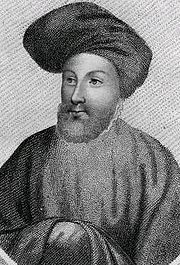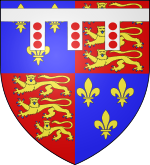- Edward of Norwich, 2nd Duke of York
-
"Edward, Duke of York" redirects here. For the 4th Duke, see Edward IV. For the brother of George III, see Prince Edward, Duke of York and Albany.
Edward of Norwich Duke of York; Duke of Aumale 
Duke of York Predecessor Edmund of Langley, 1st Duke Successor Richard Plantagenet, 3rd Duke Spouse Philippa de Mohun House House of York Father Edmund of Langley, 1st Duke of York Mother Infanta Isabella of Castile Born 1373
Norwich, NorfolkDied 25 October 1415 (aged c. 41-42)
Agincourt, FranceSir Edward of Norwich, 2nd Duke of York, 2nd Earl of Cambridge, Earl of Rutland, Earl of Cork, Duke of Aumale KG (1373 – 25 October 1415) was a member of the English royal family who died at the Battle of Agincourt.
The son of Edmund of Langley, 1st Duke of York, and his first wife Isabella of Castile. He was grandson of two kings, Edward III of England and Pedro of Castile.
Edward is thought to have been born in Norwich. He was close to his cousin King Richard II, and was created Earl of Rutland (for the term of his father's life) by him in 1390, Earl of Cork (Ireland) in about 1394,[1] and then Duke of Aumale in 1397. This association put him out of favour after the accession of King Henry IV, and he was deprived of his Dukedom. In 1400 he participated in a conspiracy against Henry IV, but betrayed the conspirators to the king. In 1402 he succeeded his father as Duke of York; the Earldom of Rutland, by its charter, then became extinct, although he continued to sign himself as Earl of Rutland. He married a widow, Philippa de Mohun, but there were no children from their marriage.
Edward wrote “The Master of Game”, a translation of the most famous of the hunting treatises of the Middle Ages, the “Livre de Chasse” of Gaston Phoebus, Count de Foix, adding five chapters of his own.[2]
Edward took part in King Henry V's war on France and died at the Battle of Agincourt, the major English casualty in that battle. Although his death is depicted by Shakespeare and his adapters as an act of heroism, it was in fact more of an accident: like many of the French knights, he was unable to remain upright when unhorsed in the fray and effectively died of suffocation under a pile of other men and horses.
On his death, the dukedom did not immediately pass to his nephew, Richard Plantagenet, as Richard's father Richard of Conisburgh, 3rd Earl of Cambridge, had been attainted for treason, but the younger Richard was eventually restored to the Dukedom.
As the Duke of Aumerle, he is a major character in William Shakespeare's Richard II, and he is also a minor character in Henry V. A
Titles, styles, honours and arms
Arms
As a grandson, in the male line, of the sovereign, Edward bore the arms of the kingdom, differenced by a label argent 3-point, per pale Castile and Leon.[3] Upon his father's death in 1402, Edward inherited his arms, which were those of the kingdom, differentiated by a label argent of three points, each bearing three torteaux gules.
References
- ^ Complete Peerage, "York", XII (part ii), p. 900
- ^ Edward of Norwich, 2nd Duke of York (1909). The Master of Game. Ballantyne, Hanson & Co. p. 195.
- ^ Marks of Cadency in the British Royal Family
Legal offices Preceded by
The Earl of KentJustice in Eyre
South of Trent
1397–1415Succeeded by
The Duke of GloucesterPeerage of England New creation Duke of Aumale
1397–1399Deprived Preceded by
Edmund of Langley, 1st DukeDuke of York
1402–1415Succeeded by
Richard Plantagenet, 3rd DukeHRH The Prince Andrew, Duke of York
Edmund of Langley (1385–1402) · Edward of Norwich (1402–1415) · Richard Plantagenet (1415-1460) · Edward of York (1460-1461) · Richard of Shrewsbury (1474-1483) · Henry (1494-1509) · Charles (1605-1625) · James (1633/1644-1685) · Ernest Augustus (1716-1728) · Edward (1760-1767) · Frederick (1784-1827) · George (1892-1910) · Albert (1920-1936)
Categories:- 1373 births
- 1415 deaths
- House of York
- Dukes of York
- Dukes of Albemarle
- Earls of Rutrland (1385)
- Knights of the Garter
- English military personnel killed in action
- People from Norwich
- Burials at the Church of Saint Mary and All Saints, Fotheringhay
Wikimedia Foundation. 2010.


